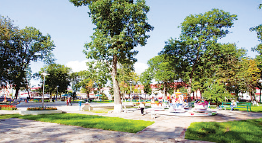By Pavel Minchenko
Gorki is a small and rather old town. This year its residents will be celebrating its 470th anniversary. However, Gorki is not a provincial place with patriarchal views and deliberations. As you walk along the streets, you can feel the place throbbing with life.

I do not know if there are any official statistics regarding this but, if I was asked to name the Belarusian city with the youngest population, I would choose Gorki without hesitation. After all, from a population of around 30 thousand residents, about a third of them are students of the Belarusian State Agricultural Academy.
The Gory-Gorki agricultural school opened in 1840 by decree of Emperor Nikolay the First, and was soon transformed into an agricultural institute. It was the first agricultural educational institution in the territory of the Russian Empire.

During that period, many things occurred for the first time. The first village regulators — today’s managers — studied here. Agrarian science and education arose here. For the first time, reclamation drainage was used, which, by the way, operates even today. The first combine harvester was also created in Gorki.
Based on the destinies of graduates, pupils of the Gory-Gorki agricultural institute, and later, the Belarusian Agricultural Academy, it is possible to learn the history of Belarusian and Russian literature. Ivan Turgenev wrote in Gorki: his serf, Fedot Bizyukin, studied here. Kobza player, Taras Shevchenko, was on friendly terms with Korolev, who was a teacher at the institute and a Gorki student, Pavel Bakhmetiev, was the inspiration for Rakhmetov in the novel What to Do? by Nikolay Chernyshevsky. Traces of the legendary poem Taras on Parnassus also lead to Gorki.

The townspeople like to walk along academgorodok (academic town). Here, there is small ‘Arbat’, a cosy small pedestrian street. Almost everywhere you see young mums with strollers or babies in their arms. The city has no reasons to worry about its future and the local people strictly keep order. For example, a guy ahead of me threw a wrapper from his ice-cream in a refuse bin but missed it. He bent down and picked up the litter. It is a trifle, but it is so pleasant to see...

Not far from the academy, in an ancient building, there is the local history museum. Once I was told a very curious story about the former owner of this house. His was a pharmacist called Kazimir Padzersky. This dwelling was not only his home, but his pharmacy too. Padzersky became famous for a cream that prevented freckles. At the World’s Fair in Paris, he was given a gold medal for this creation. The cream was sold across the Russian Empire, and in pre-revolutionary newspapers, there were many warning advertisements about the purchase of fakes. Padzersky earned a lot of money from his invention, but unfortunately, the recipe of this cosmetic marvel, for which many modern women would pay a fortune, is lost. However, historical justice has to some extent prevailed. The museum exposition has a ‘chemist’s corner’, recreating part of the establishment which existed here in the past. The museum also boasts receipt stubs from Padzersky’s pharmacy which were found during the restoration, and even an ancient cash register. The museum workers offered to move it, but the iron contraption did not move. It appeared that in those days, cash registers were purposefully made very heavy in order to deter people from stealing it together with the money.

A children’s park is situated near museum. Near to this favourite place for the youngsters is a local children’s school of arts and crafts. When you enter the corridor, you realise that really talented children study here; the whole gallery of diplomas is evidence of that. These diplomas have been won by pupils at republican and international competitions. When asked about how many diplomas were hanging there, the director of the school, Lyudmila Stavskaya smiles, “I did not count, but more than 100...”

When the school first opened 1995, it was the first of its kind in Belarus. Now other cities have educational institutions where children master the art of workmanship. However, in Gorky people also revive the traditions — for example, weaving which was once forgotten. There is also a handmade weaving loom, as well as ancient one was found and put into use. When a computer club was opened near the school, the teachers worried that it may ‘entice’ children away. However, there was no need to be afraid. The boys and girls played a little and then returned. Each year, more and more children wish to master elements of weaving, plaiting from straw and ceramics and, apart from this craft school, Gorki children also attend a vocal-choral school and children’s school of art; both of which are excellent.

Not so long ago, in the suburbs of the city, an ice palace appeared. I decided to drop in and take a look. I thought that I would be greeted by emptiness and silence — after all it was the middle of the working day and students and pupils were at class. But it was very busy on the ice arena as children’s ice-hockey teams battled each other. It was just like an adult game. The board displayed the results, judges on skated on the playground, and spectators on tribunes.

The director of the ice palace, Vladimir Korolev, says that the rink is almost never empty. People come here to skate and sports sessions are held here — and not only for Belarusians, but also Russian sportsmen train here too. For example in July, 20 young hockey players from St. Petersburg will arrive. Informal fans of hockey have taken a fancy to this arena. On social networks they announce they are carrying out their own mini-tournament. And for several days players from St. Petersburg, Moscow and Tver will gather in Gorki to find out whose team is the strongest. The ice palace is ready and happy to organise such informal competitions almost every month.











